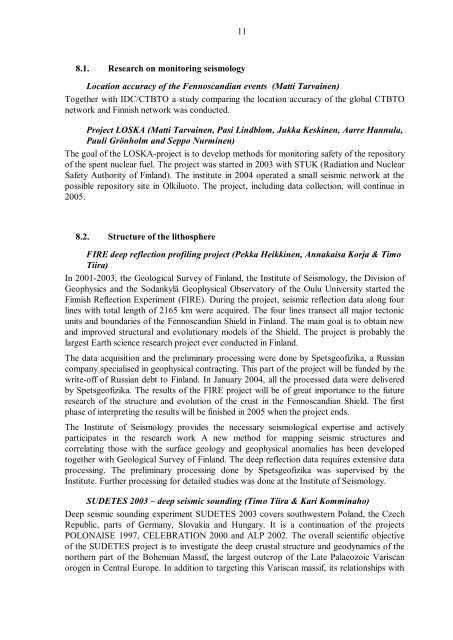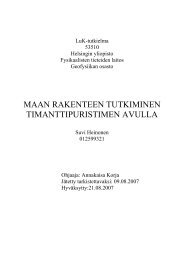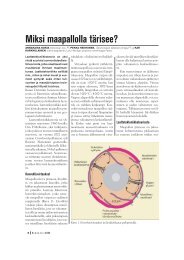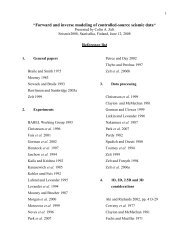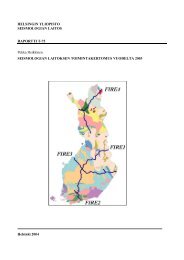Annual report 2004 - Helsinki.fi
Annual report 2004 - Helsinki.fi
Annual report 2004 - Helsinki.fi
You also want an ePaper? Increase the reach of your titles
YUMPU automatically turns print PDFs into web optimized ePapers that Google loves.
11<br />
8.1. Research on monitoring seismology<br />
Location accuracy of the Fennoscandian events (Matti Tarvainen)<br />
Together with IDC/CTBTO a study comparing the location accuracy of the global CTBTO<br />
network and Finnish network was conducted.<br />
Project LOSKA (Matti Tarvainen, Pasi Lindblom, Jukka Keskinen, Aarre Hannula,<br />
Pauli Grönholm and Seppo Nurminen)<br />
The goal of the LOSKAproject is to develop methods for monitoring safety of the repository<br />
of the spent nuclear fuel. The project was started in 2003 with STUK (Radiation and Nuclear<br />
Safety Authority of Finland). The institute in <strong>2004</strong> operated a small seismic network at the<br />
possible repository site in Olkiluoto. The project, including data collection, will continue in<br />
2005.<br />
8.2. Structure of the lithosphere<br />
FIRE deep reflection pro<strong>fi</strong>ling project (Pekka Heikkinen, Annakaisa Korja & Timo<br />
Tiira)<br />
In 20012003, the Geological Survey of Finland, the Institute of Seismology, the Division of<br />
Geophysics and the Sodankylä Geophysical Observatory of the Oulu University started the<br />
Finnish Reflection Experiment (FIRE). During the project, seismic reflection data along four<br />
lines with total length of 2165 km were acquired. The four lines transect all major tectonic<br />
units and boundaries of the Fennoscandian Shield in Finland. The main goal is to obtain new<br />
and improved structural and evolutionary models of the Shield. The project is probably the<br />
largest Earth science research project ever conducted in Finland.<br />
The data acquisition and the preliminary processing were done by Spetsgeo<strong>fi</strong>zika, a Russian<br />
company specialised in geophysical contracting. This part of the project will be funded by the<br />
writeoff of Russian debt to Finland. In January <strong>2004</strong>, all the processed data were delivered<br />
by Spetsgeo<strong>fi</strong>zika. The results of the FIRE project will be of great importance to the future<br />
research of the structure and evolution of the crust in the Fennoscandian Shield. The <strong>fi</strong>rst<br />
phase of interpreting the results will be <strong>fi</strong>nished in 2005 when the project ends.<br />
The Institute of Seismology provides the necessary seismological expertise and actively<br />
participates in the research work A new method for mapping seismic structures and<br />
correlating those with the surface geology and geophysical anomalies has been developed<br />
together with Geological Survey of Finland. The deep reflection data requires extensive data<br />
processing. The preliminary processing done by Spetsgeo<strong>fi</strong>zika was supervised by the<br />
Institute. Further processing for detailed studies was done at the Institute of Seismology.<br />
SUDETES 2003 –deep seismic sounding (Timo Tiira & Kari Komminaho)<br />
Deep seismic sounding experiment SUDETES 2003 covers southwestern Poland, the Czech<br />
Republic, parts of Germany, Slovakia and Hungary. It is a continuation of the projects<br />
POLONAISE 1997, CELEBRATION 2000 and ALP 2002. The overall scienti<strong>fi</strong>c objective<br />
of the SUDETES project is to investigate the deep crustal structure and geodynamics of the<br />
northern part of the Bohemian Massif, the largest outcrop of the Late Palaeozoic Variscan<br />
orogen in Central Europe. In addition to targeting this Variscan massif, its relationships with


